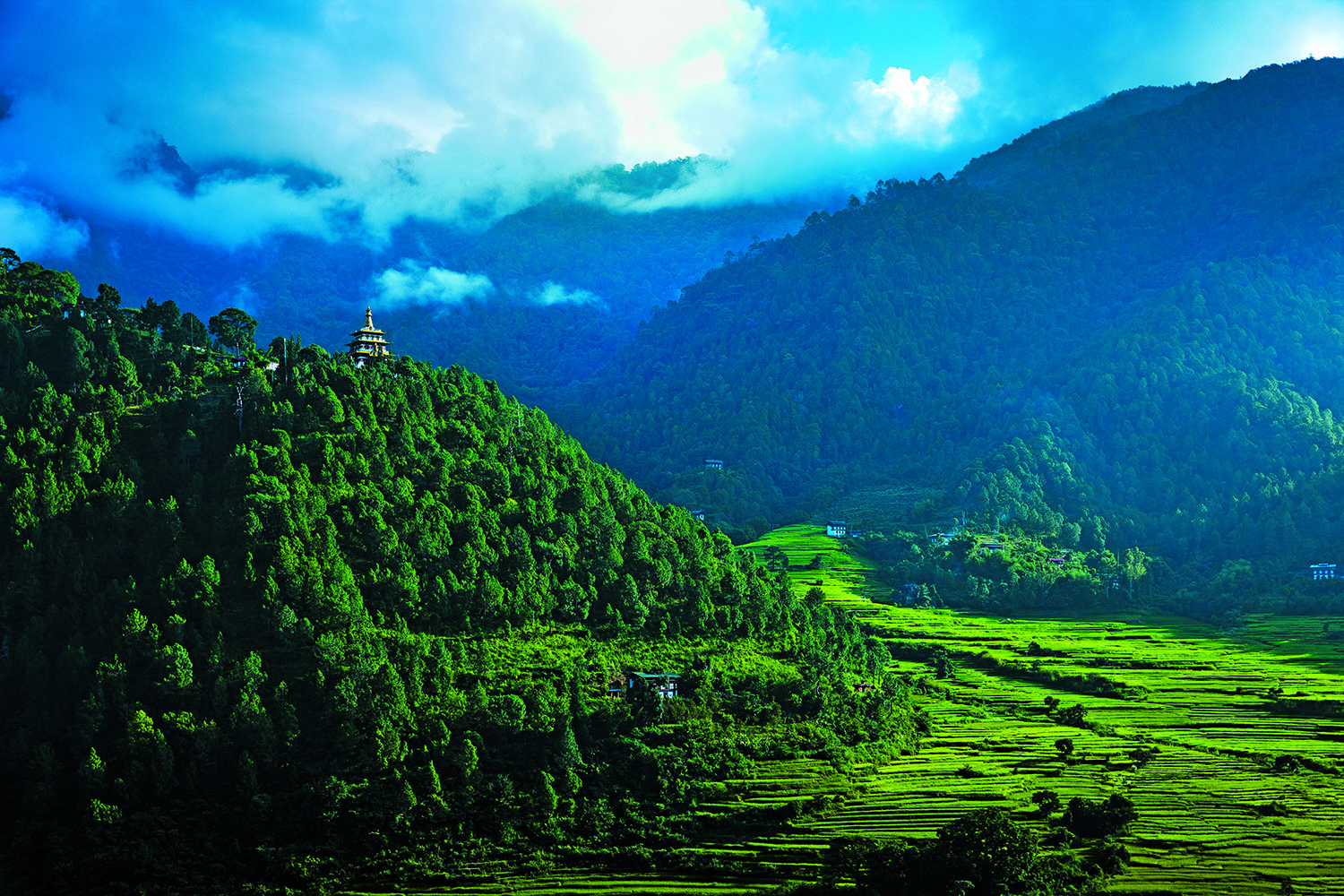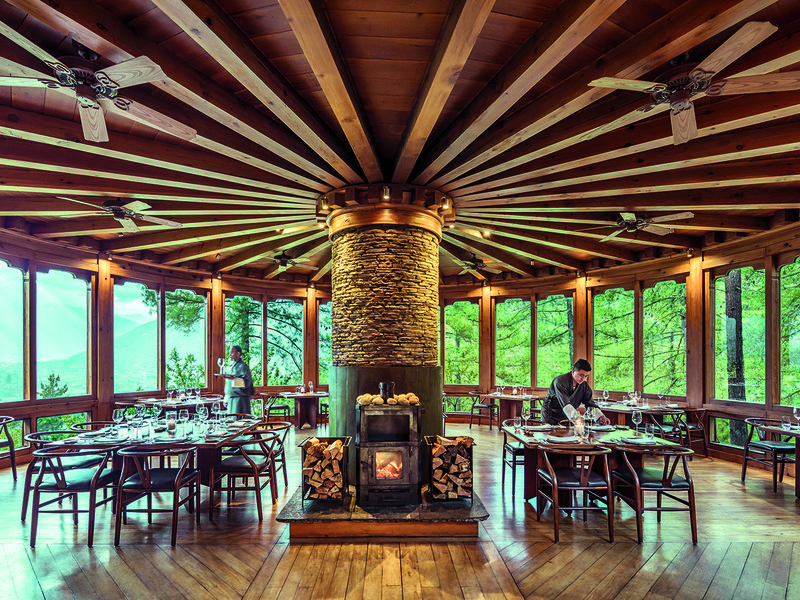The block-letter statement “NO HURRY, NO WORRY” marks my introduction to what will be a journey in gentle wisdom from Bhutan. Hand-painted on a yellow board, it’s one in a series of roadside messages that transcend the typical directives of traffic signs. Instead, they offer blunt, dry, humorous and occasionally life-affirming mantras that echo the philosophy embraced by this remote kingdom.
The country’s unique approach to development, rejecting GDP in favour of gross national happiness has earned itself an intriguing status as a real-life “Shangri-La”. Landlocked and encompassed by the Himalayas, it’s adorned with ancient monasteries, blanketed by forests and fluttering prayer flags abound. Having opened its borders to the world less than 50 years ago, it has since pursued a holistic measure of prosperity, focusing on the well-being of its citizens and the natural environment, a testament to its commitment to a meaningful and fulfilling existence.
It’s because of COMO Hotels that I have the chance to discover the happiest land on earth. In five days, I’m to journey from Paro to Punakha, with guide Tshering and driver Phurpa, uncovering some of Bhutan’s cultural and natural wonders. Those fortunate enough to have visited before often report on how Bhutan’s unique charm promises a transformative experience, blending luxury with a deeper connection to the country’s soul. I’m on a quest to slow down, embrace its unhurried pace and find joy in simplicity. It’s the latter that holds the most power.
Between landing in the country and taking off once again, there are a lot of ups and downs. But this refers mostly to differences in altitude, rather than emotions. I plummet into Paro – a marvel of an airport that sits at 2,000 metres above sea level and is surrounded by snow-capped peaks. Scooped up by Tshering and Phurpa, I’m steered immediately up snake-like mountain roads bound for Dochula Pass. At the top, or 3,140 metres above sea level, I’m standing amid 108 chortens (Buddhist shrines) that honour fallen soldiers, a poignant reminder of Bhutan’s commitment to peace. From this vantage point, the eastern Himalayas – with Gangkhar Puensum, the world’s highest unclimbed mountain and Bhutan’s towering pride – stand beneath a cornflower blue sky. The brilliant October sunshine makes me squint while taking in the view. And breathing in pristine air from up high is something I almost never experience.
A winding drive down to Punakha Valley reveals the grandeur of the Punakha Dzong, a 300-year-old fortress at the confluence of the pristine Pho Chhu and Mo Chhu rivers. Built in the 17th century by Zhabdrung Ngawang Namgyal (who founded the Kingdom of Bhutan), it once housed the country’s government. Today it’s the winter home of the dratshang (the official monk body).
COMO Uma Punakha sits in a dramatic location a short drive from this fortress, in a cradle of lush valleys and terraced rice paddies. Having topped many a luxury-travel bucket list over the years, this petite lodge-style property has a small yet sensational spa (a signature massage from therapist Nima should be compulsory) and an equally excellent restaurant, Bukhari. The same outlet (but with its own distinct atmosphere) is found at Como Uma Paro.
Deciding between Western courses made from produce grown nearby, regionally-inspired dishes influenced by Indian flavours, or Bhutanese specialities such as river weed egg drop soup, braised yak or curries tinged with chillies served over local red rice, is no easy matter.
After breakfast on my first morning in Punakha, Tshering and I set off on a day of exploring. Starting at a suspension bridge, we’re bound for the Khamsum Yulley Namgyal Chorten, a shrine built recently by Her Majesty Ashi Tshering Yangdon. Keeping a moderate pace along rough-hewn paths, we come across women carrying laden cane-woven baskets, the occasional farmer milking his cows, and children playing in the fields or close to mounds of harvested rice shaped like stupas drying in the morning sun. Tshering makes sure we take time to learn about medicinal plants which grow beneath flame-red poinsettias and even banana trees. Halfway up, we stop to circle a spinning golden prayer wheel, its tinkling bell tuning into birdsong as it goes.
It takes an hour or so to reach the multi-storey chorten, depending on fitness and how camera trigger-happy you are. From the shrine’s top, a pictorial gorge unfolds below, with rolling hills and a jade-coloured river gushing beneath. Inside it are depictions of Buddhist deities meant to protect the country. Vajrayana Buddhism is the main religion here, introduced in the eighth century by Guru Padmasambhava.
Spotting my interest in his spirituality, Tshering weaves in information about this throughout our time together. I appreciate his taking me to meet an artist, Yonten, after our morning hike. Yonten is deeply immersed in the vibrant tradition of thangka craft – intricate scroll paintings that are created with mineral pigments and gold leaf. These serve as spiritual artefacts, depicting divinities and scenes from scriptures, while at the same time showcasing his devotion.
His studio, Vintage Quality Thangka, is not far from Chimmi Lhakhang, a 15th-century fertility temple dedicated to Drukpa Kuenley, the ‘Divine Madman’. Tshering’s tales of this eccentric Tibetan Buddhist saint who defied convention with unorthodox teachings add an intriguing layer to my visit in Bhutan. There’s enough material to write a whole other story.
Tshering also participates in my propensity for discovering as much of a country’s cuisine as possible – no matter how short the trip. Whether suggesting what to order from COMO’s carefully curated menus, handing me cups of butter tea (like bullet coffee, but with puffed cereals on the side), pointing out garlic-like hanging garlands of dried-hard cheese (“they’re like candy, to keep drivers awake”) or sharing a bounty of buckwheat dumplings (hoentey) or short, fat ‘puta’ noodles with me, he certainly plays my game well.
A memorable meal is at Chimmi Lhakhang Home Stay – courtesy of COMO Punakha and Tshering. There, Dago Zam and her husband Tshering Penjor cook up a traditional feast featuring ema datshi – a fiery chilli and cheese stew. It stands as the country’s culinary emblem – and is nothing like I’ve tasted before. Amid staples like their own red rice, a cucumber salad, a sort of sambal made from sun-dried chillies that were left to laze on the rooftop, and a chicken curry, a surprise lies in fried turnip leaves – Dago’s creative twist adding a unique texture and flavour to this traditional fare.
I check into COMO Uma Paro for the last leg of my trip. Hidden amid blue pine trees above Paro town, this hillside retreat with a main lodge (once a nobleman’s home) and separate villas, is modelled after a traditional Bhutanese village. Overall, its aesthetic allure marries traditional artisan-crafted woodwork and hand-painted walls with sleek mod cons.
Its spa sanctuary – the COMO Shambhala Retreat is an embodiment of the brand’s international wellness ethos. It offers a roster of complimentary evening yoga classes and Asian-inspired spa treatments as well as an exquisite bath house.
For over 13 centuries, hot-stone baths have been an essential element of Bhutanese culture, tracing back to the seventh century and influenced by Tibetan medicine and Indian Ayurveda. The practice combines river water infused with healing plants and tree barks, including the fragrant wormwood. It’s the mineral-rich rocks used to heat the water that make this experience distinctive. They’re heated in an open fire outside the facilities, then deposited through a hatch in the wall into a separate section of the bath. As the oddly-shaped white rocks break the water’s surface, they spit and sizzle, heating the water. This sensory bath experience promises to help with the likes of headaches and aching muscles. Knowing I’ll suffer from both ailments after an imminent gruelling hike, I book a 30-minute session.
Tshering keeps THAT hike to the famous Paro Taktsang or Tiger’s Nest for the last day of my trip. Built in 1692, this sacred Buddhist site sits on a craggy perch at 3,120 metres above sea level and 900 metres above the Paro Valley. Legend has it that Guru Rinpoche, a revered figure in Buddhism, rode on the back of a flying tigress to this spot where he proceeded to meditate in a cave for three years, three months, three weeks and three days.
Clinging to a precipice in a gravity-defying manner, the Tiger’s Nest is one of the most remarkable feats of architecture in Bhutan.
We begin our pilgrimage at around 8am. I’m raring to go, but have developed the flu overnight, so start with a spinning head and cough – what a disadvantage! It’s a hard, breathless slog to the halfway point. Tshering reminds me softly to take baby steps – what’s the rush? He ensures we stop for snack and water breaks constantly. Phurpa puts his arm out as support for close to every step of the way.
Despite struggling to breathe, I’m adamant to reach the Nest. Thoughts run through my head about how I always reach my goals – and I insist we press on to the next look-out point where it’s suddenly well in sight.
But it’s here I begin to teeter and my pilgrim party draws the line. In Bhutan, time takes on a different rhythm – a measured cadence that allows for introspection, acceptance and appreciation. A whispered reminder from Phurpa that right now my heart is more important than our initial mission makes me accept it’s time to descend.
Heading down, I think about how happy I am to have come this far. I’ve met friends who in a short time feel like family and I’m thrilled to have visited Bhutan.
I’m also reminded of another of those road signs I’ve seen: “Life’s a journey, complete it”. I am here for the ride.
To plan your trip to Bhutan with COMO Hotels visit comohotels.com















